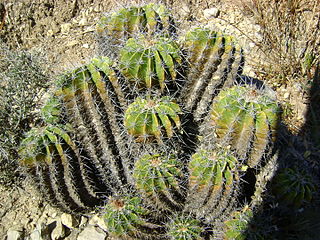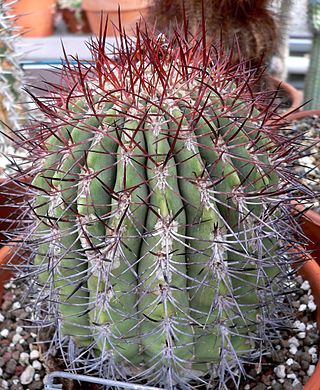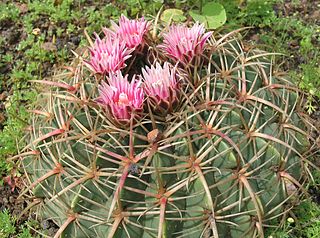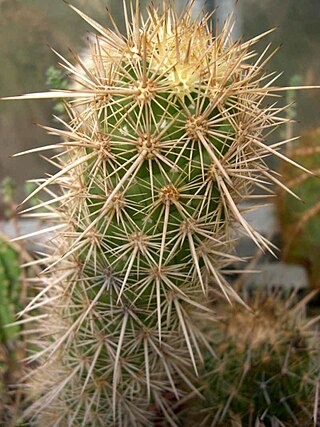
Ferocactus glaucescens, the glaucous barrel cactus, is a species of flowering plant in the family Cactaceae, native endemic to México.

Ferocactus echidne is a barrel cactus in the genus Ferocactus. It is found in nature in Mexico. This cactus is known commonly as Sonora barrel, Coville's barrel cactus, Emory's barrel cactus, and traveler's friend. This plant is often sold as a houseplant.

Ferocactus robustus is a barrel cactus in the genus Ferocactus of the family Cactaceae.

Ferocactus fordii is a species of succulent plant in the family Cactaceae, commonly known as Ford's barrel cactus, endemic to the Baja California Peninsula of Mexico. It is spherical, growing to 50 cm (20 in) in diameter, with whitish-grey radial spines and solitary flowers of a deep rose pink, 4 cm (2 in) in diameter.

Ferocactus hamatacanthus, commonly named Turk's Head, is a barrel cactus in the tribe Cacteae.

Lobivia cinnabarina is a species of cactus first described in 1885.

Thelocactus rinconensis, synonyms including Thelocactus nidulans, is a species of cactus. It is endemic to north-east Mexico.

Ferocactus alamosanus is a species of Ferocactus from Mexico.

Ferocactus chrysacanthus, commonly known as the Cedros barrel cactus, is an endangered species of cactus endemic to the islands of Cedros and West San Benito off the Pacific coast of Baja California, Mexico.

Ferocactus diguetii, commonly known as the giant barrel cactus, is the largest species of barrel cactus in the genus Ferocactus. It is an insular species endemic to several of Baja California Sur's southern islands in the Gulf of California. As the superlative giant of the barrel cacti, it reaches heights of up to 4 metres (13 ft) and diameters of 1 metre (3.3 ft) in the wild, a result of island gigantism. The species has red flowers that bloom from March to May. Although restricted in range, this species grows in protected habitat and lacks major threats.

Ferocactus flavovirens is a species of Ferocactus from Mexico.

Ferocactus townsendianus, commonly known as the Townsend barrel cactus, is a species of cactus endemic to southern Baja California Sur in Mexico. It is a barrel cactus that grows solitary stems up to 1 metre (3.3 ft) tall, with gray to brown spines, with one central spine on each areole usually curved or hooked at the tip, and orange to red flowers that bloom from May to August. Ferocactus townsendianus is similar to both Ferocactus peninsulae and Ferocactus santa-maria, and is sometimes placed under peninsulae as a variety or subspecies.

Denmoza is a monotypic genus of cacti. Its only species, Denmoza rhodacantha, is native to northwest Argentina.

Ferocactus macrodiscus is a species of cactus in the genus Ferocactus from Guanahuato and Oaxaca States, Mexico.

Cochemiea poselgeri is a species of Cochemiea found in Mexico

Cochemiea albicans is a species of Cochemiea found in Mexico.
Cochemiea cerralboa is a species of Cochemiea found in Mexico.

Cochemiea halei is a species of Cochemiea found in Mexico.
Cochemiea pondii is a species of Cochemiea found in Mexico.

Echinocereus barthelowianus is a species of cactus native to Mexico.

























